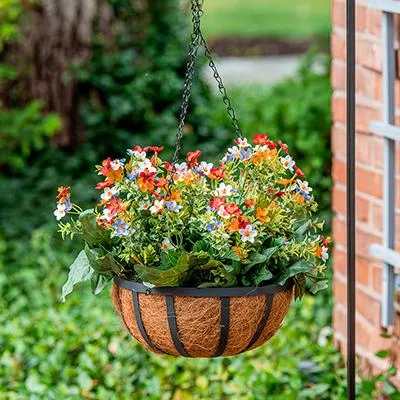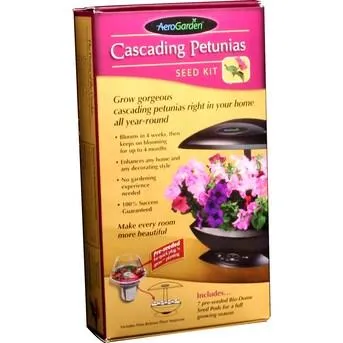Everything You Need to Know About Cascading Plants
Cascading plants are a type of trailing or hanging plant that grow downward, sometimes reaching the floor. From my experience as an avid gardener, they make beautiful additions to hanging baskets, overhead planters, or when placed on elevated surfaces like shelves. In this article, I’ll reveal everything you need to know about cascading plants to pick the perfect one for your space.
Popular Types of Cascading Plants
- Ivy: English ivy is a classic cascading plant known for its ability to grow extremely long vines. It thrives in partial shade but can tolerate sun with sufficient water.
- Creeping Jenny: With its delicate green leaves and trailing stems, Creeping Jenny is a versatile option. It’s fairly low maintenance and spreads quickly to fill out containers.
- Wandering Jew: Coming in various vivid colors, Wandering Jew has trailing leaves and stems that cascade beautifully. It prefers bright, indirect light.
- Swedish Ivy: Related to Pothos, Swedish Ivy has heart-shaped leaves in green, yellow or variegated forms. It’s extremely hardy and tolerates neglect well.
- Tradescantia: Also called Spiderwort, this type is known for its purple, pink or white flowers. It thrives in sun or shade and makes an eye-catching splash of color.
Those are some of the most common cascading plants, but there are many other excellent options too like fountain grass, Chinese evergreen, or sweet potato vine. Basically, any trailing variety can work if given the right growing conditions.
Care Requirements for Cascading Plants
In general, cascading plants need water, sunlight and nutrition to grow their lengthy vines. Here are some key things to keep in mind when caring for them:
- Water when the top 1-2 inches of soil dry out. Most prefer consistently moist soil but not soggy mud.
- Provide partial shade to full sun depending on the specific type. Swedish Ivy for example tolerates low light better than Creeping Jenny.
- Fertilize monthly in spring and summer with a diluted all-purpose plant food. Cut back on feeding in winter.
- Prune regularly to control size and shape. You can cut off lengths of vines to propagate new plants too.
- Repot annually in spring into a container at least 2 inches wider than the root ball. Use a soil-less potting mix.
The key is matching each cascading plant to the sunlight conditions where you plan to grow it. As long as their needs are met, they basically maintain themselves with very little effort.
Ideal Locations for Cascading Plants
Based on my experience, cascading plants sort of kill it in the following areas:

- Hanging baskets: Their long vines spill beautifully over the edges of cans, boxes or hanging pots. English ivy is the classic choice here.
- Shelves and stairways: Train vines up and over ledges for an instant lush, jungle vibe. Wandering Jew varieties work well in these spots.
- Overhead planters: Let vines trail down from pots, urns or window boxes above. Creeping Jenny, Sweet Potato Vine and Swedish Ivy handle these elevated situations well.
- Arbors and pergolas: Encourage growth up and through latticed structures for cascades of greenery. Hardy climbers like Purple Heart, Hollies or Climbing Hydrangea seriously impress here.
- Balconies or patios: Take advantage of vertical space by attaching pots to railings. Consider heat and drought tolerant types like Lantana, Fountain Grass or Bougainvillea for outdoor use.
Basically anywhere you see an opportunity for foliage to flow downward, a cascading plant could totally make the space. It’s amazing what a dash of creeping color can do to liven things up.
Design Tips for Cascading Plants
Once you pick out some trailing varieties, here are some tips for incorporating them into your space efficiently:
- Group types with similar needs together for easier care, like low-light ivy with pothos.
- Fill out hanging baskets from the edges inward for maximum spill-over effect.
- Train vines onto trellises, poles or wires to shape their direction of growth.
- Add vertical interest by pairing with upright plants in contrasting textures.
- Anchor pots securely wherever they’ll grow overhead for safety.
- Refresh arrangements periodically by moving plants to empty spots for new perspectives.
- Use multiple pots of the same types together for more striking visual impact.
With a bit of playing around, cascading plants can seriously upgrade whatever area you put them in. There’s no limit to how creative you can get with their placement.
Real-Life Success Story
Speaking from experience, I once rescued an ugly concrete stairwell at my office with cascading plants. It was basically this drab, sad area that nobody wanted to look at. On a whim, I attached lots of small terra cotta pots to the railing filled with Creeping Jenny, Ivy and Swedish Ivy. Over time the vines grew together, intertwining softly down the steps.
Coworkers literally stopped and stared in amazement at the transformation. The dingy grey staircase was suddenly lush with green and it totally changed the vibe of that whole hallway. Best of all, the plants basically maintained themselves with minimal care. It goes to show how powerful a simple touch of nature can be – literally taking an area from drab to fab!

Common Problems and Solutions
Like any plant though, cascaders might hit a few snags. Here are some issues I’ve faced before and how to solve them:
- Leaf drop: Usually due to over/under watering. Adjust water schedule and check for pests then leaves should regrow.
- Stunted growth: May lack nutrients, light or be root bound. Fertilize, adjust light and repot into larger container with fresh soil.
- Mealybugs or scale: Isolate infected plant and treat visible pests with neem oil or insecticidal soap. Repeated application may be needed.
- Browning tips: Too much direct sun or dry air. Move plant to a shadier spot and increase humidity by grouping containers together.
- Leggy vines: Sign of low light. Move plant to a brighter window or supplement with grow lights to encourage bushier growth.
Basically if you keep up with regular care, cascading plants bounce back pretty easy from minor issues. With patience and TLC, you can keep them thriving for year after year.
Final Thoughts
In conclusion, whether spilling from hanging baskets or framing an archway overhead, cascading plants add such amazing greenery to any space. Their low maintence and flexibility make them a simple way to make your environment instantly more vibrant. What are you waiting for?
Grab a few trailing varieties suited to your conditions, get planting and just watch them transform the vibe. Over time, their long vines will grow and flow so naturally wherever you guide them. I promise, you and your cascading plant buddies will awe everyone who sees them – kind of like my office staircase situation! Give it a try and let me know how it goes.
Choosing a Cascade Plant
| Type of Plant | Water Needs | Light Requirements | Great for Beginners? |
|---|---|---|---|
| Pothos | Low – Let dry out between waterings | Low – Thrives in shade | Yes – Hard to kill |
| Philodendron | Medium – Water when top inch of soil is dry | Medium – Bright indirect light | Yes – Very low maintenance |
| Chinese Evergreen | Medium – Wait until top inch of soil is dry | Low-Medium – Tolerates low light | Yes – Colorful leaves, easy to care for |
| Peace Lily | Medium – Let top inch of soil dry between waterings | Medium – Tolerates low light if watered less | Yes – White flowers signal when to water |
| Spider Plant | Low – Let dry between waterings | Medium – Thrives in sunny window | Yes – Produces baby plants, very hardy |
FAQ
-
What is a cascading plant?
A cascading plant is a type of houseplant that grows long stems or vines which can hang down over the side of its pot.

-
What are some common examples of cascading plants?
Some popular cascading plants include English ivy, pothos, potato vine, tradescantia, spider plant, and nephthytis. Certain types of succulents and air plants also work well as hanging plants.
-
How do you care for a cascading plant?
Cascading plants need bright, indirect light and well-draining soil. Water them when the top inch of soil becomes dry. You can pinch back stems to encourage bushier growth. Clean dust from leaves occasionally with a damp cloth.
-
What kind of pot should I use?
Look for a tall, narrow container for cascading plants. Terra cotta pots, woven baskets, or hanging planters with drainage holes allow roots to breathe and excess water to drain away. The container should be large enough that the plant’s roots don’t become pot bound.
-
Where can I put a hanging plant?
Cascading plants work nicely hung in windows, over shelves, or on walls. They also look amazing dangling from ceilings! However, be sure the hook or hanger can support the weight of a soaked pot. Outdoor cascading plants brighten porches and patios.
-
Will a cascading plant need staking or support?
Depending on the variety, very long trailing stems may require kind of staking as the plant matures. Use twisted wire or floral ties to gently train stems into an artful cascade rather than a tangled mess. Plastic plant stakes can guide stems without damaging tender growth.

-
What if my cascading plant isn’t very full or lush?
Sometimes new cascading plants struggle to adjust or lack enough growth points to thrive quickly. Be patient and snip off unsightly bare stems. Cascading plants will fill in over months. You can even propagate new plants from stem cuttings to thicken a sad plant’s appearance.
-
Is there anything else I should know?
Be mindful where soil spills when watering hanging pots. Watch for signs of pests like spider mites under leaves. Repot annually in spring if roots poke through drainage holes. Despite occasional challenges, cascading plants can add such fun energy and curtains of green to any indoor or outdoor space!
